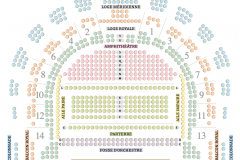Mozart, The Abduction from the Seraglio
Mo | Tu | We | Th | Fr | Sa | Su |
Mozart: The Abduction from the Seraglio | Staged Opera
Opera in three acts with a libretto by Johann Gottlieb Stephanie, premiered in Vienna in 1782.
French translation by Pierre-Louis Moline (1739-1820), French dramatist and librettist.
Performance in French with surtitles in French and English.
Duration: 2h50 including intermission
A masterpiece of opéra comique finds its Mozartian or French vein
In 1781, the young Mozart left the city of Salzburg and his position with Archbishop Colloredo, with whom he no longer got along. He then settled in Vienna, the musical capital, which he set out to conquer. To make a name for himself in the opera world, the young composer took advantage of a commission from Emperor Joseph II for the Burgtheater. He then composed an opera that moved away from the highly codified opera seria to develop a more national genre: the singspiel, a comic opera that would be his first opera in the German language.
The opera was premiered one month after its completion, in July 1782, under the composer’s direction. The reception was triumphant, and the emperor did not fail to congratulate Mozart while making a now-famous remark: “Too beautiful for our ears and far too many notes, my dear Mozart!” To which the composer is said to have cheekily replied, “Just as many as necessary, Your Majesty!” The opera was then restaged in Vienna, then in Prague, Leipzig, and Salzburg, marking the beginning of Mozart’s Viennese career at the age of twenty-six!
What may have charmed and surprised the emperor, as well as the rest of the audience, was surely the boldness of the composition visible through the multiplication of effects and its irresistible joyfulness. Here Mozart yields to the vogue for Turkish themes both in the choice of subject and in the use of instruments evoking a certain orientalism: piccolo, triangle, and cymbals, which are heard from the overture simulating the fanfares of the janissaries.
Gaétan Jarry, leading the choirs and orchestra of the Opéra Royal, restores all the flavor of Mozart’s music, enhanced by the staging of the great opera enthusiast Michel Fau, and by a French-language version that sounds with absolute clarity!
Delegated production Opéra Royal / Château de Versailles Spectacles
Coproduction Opéra de Tours Centre – Val de Loire.
Costumes created by the workshop of the Opéra de Tours and Corinne Pagé.
PRESTIGE VIP CATEGORY: The best seats in the house, the program will be offered along with a glass of champagne.
PRESTIGE CATEGORY: Very good seats, the program will be offered along with a glass of champagne.
Program and cast
Florie Valiquette - Constance
Mathias Vidal - Belmont
Nahuel di Pierro - Osmin
Gwendoline Blondeel - Blonde
Enguerrand de Hys - Pédrille
Michel Fau - Sélim
Choir of the Opéra Royal
Orchestra of the Opéra Royal
Gaétan Jarry, Conductor
Michel Fau, Staging
Antoine Fontaine, Set Design
David Belugou, Costumes
Joël Fabing, Lighting
Laurence Couture, Makeup, Hair, and Wigs
Sofiène Remadi, Artistic Collaboration on Staging
Tristan Gouaillier, Assistant Director
Program
Sung in French.
Performance in French with surtitles in French and English.
Opera in three acts with libretto by Johann Gottlieb Stephanie, premiered in Vienna in 1782.
French translation by Pierre-Louis Moline (1739–1820), French playwright and librettist.
Revival.
First part: 1h40
Intermission
Second part: 40 minutes
Palace of Versailles Opera Theater
Royal Opera
The Royal Opera of Versailles, located in the grounds of the Castle, one of the major opera houses.
The opening of the opera house at Versailles brought to a close a process of planning, projects and designs that had lasted for nearly a century. While the Royal Opera was finally built towards the end of the reign of Louis XV, it had been envisaged since as early as 1682, the year when his predecessor Louis XIV took up residence at Versailles. The King had commissioned Jules Hardouin-Mansart and Vigarani to draw up plans for a ballet theatre. Mansart shrewdly decided on a position at the far end of the new wing that was to be built over the coming years: the nearby reservoirs for the gardens’ fountains could be used to fight any fire that might break out, while the sloping ground on that part of the site would allow provision of the necessary technical spaces below the stage without major excavation work. So cleverly-chosen, indeed, was the planned location that none of Mansart’s successors ever questioned it.
Major building work was already under way in 1685, but was soon interrupted because of the wars and financial difficulties which beset the later part of the king’s reign. Louis XV in his turn was long put off by the huge expense involved in the project. As a result, for almost a century the French court was forced to put up with a makeshift theatre installed below the Passage des Princes. When a grand opera was required, with a large cast and complicated stage machinery, a temporary theatre would be built in the stables of the Grande Ecurie, with the entire structure being demolished once the performances were over. This temporary solution was adopted, for instance, during the celebrations of the Dauphin’s wedding in February 1745, but its inconvenience was so starkly obvious that Louis XV finally resolved to build a permanent theatre, entrusting its design to his first architect, AngeJacques Gabriel.
The process of actually building the new theatre, however, was to take over twenty years. During this lengthy period of construction Gabriel, who had studied the leading theatres of Italy, in particular Vicenza, Bologna, Parma, Modena and Turin, presented a series of different designs to his royal patron, none of which was accepted. Only in 1768, faced with the forthcoming successive marriages of his grandchildren, did the king finally give the order for work to commence. Building progressed steadily and the new opera house was completed in twenty-three months, ready for its inauguration on the 16th of May 1770, the day of the Dauphin’s marriage to the Archduchess Marie-Antoinette, with a performance of Persée by Quinault and Lully.
Royal Chapel
This extraordinary two-level palatine chapel was built by Jules Hardouin Mansart between 1699 and 1708 and completed by Robert de Cotte in 1710.
The paintings on the vaulted ceiling by Antoine Coypel, Charles de la Fosse and Jean Jouvenet, as well as the lavish decoration fashioned by a team of sculptors working for Louis XIV, depict a number of Old and New Testament scenes. Facing the royal gallery is the remarkable organ, created by Robert Clicquot, the King's organ builder, which was first played on Easter Sunday 1711 by François Couperin.
Even though Hardouin-Mansart did not witness the completion of the chapel, he was the one who had dictated the major aspects of the architecture and decor: a ground floor with a nave, aisles and ambulatory, and an upper floor with galleries, a harmonious combination of white and gold contrasting with the polychromatic marble floor and paintings on the vaulted ceiling, all combining to create an original space with references to both gothic architecture and baroque aesthetics.
Every day, generally at 10 a.m., the court would attend the King's mass. The King would sit in the royal gallery, surrounded by his family, while the ladies of the court would occupy the side galleries. The "officers" and the public would sit in the nave. The King would only descend to the ground floor for important religious festivals when he would take communion, for Order of the Holy Spirit ceremonies and for the baptisms and weddings of the Children of France, which were celebrated there between 1710 and 1789. Above the altar, around the Cliquot organ played by the greatest virtuosos of their age, including François Couperin, the Chapel Choir, renowned throughout Europe, would sing motets throughout the entire service, every day.
The Orangerie gardens
From May to October, orange trees and other shrubs are taken out of the Parterre Bas of the Orangerie gardens. At the center of this parterre, there is a large circular pool surrounded by six sections of lawn.
Orangerie
A great stone cathedral within a formal garden, The Orangerie is both a royal and magical place.
Built between 1684 and 1686 by Jules Hardouin-Mansart to house and protect precious trees and shrubs during the Winter, this extraordinarily large building is located beneath the parterre du Midi (South flowerbed), for which it acts as a support. Two monumental staircases, known as "les Cent Marches" (the hundred steps), frame the Orangerie's three galleries, which overlook the parterre where, during the Summer, more than 1,200 exotic trees are arranged.

 EN
EN DE
DE IT
IT FR
FR ES
ES RU
RU JP
JP RO
RO
 Seating plan
Seating plan 
